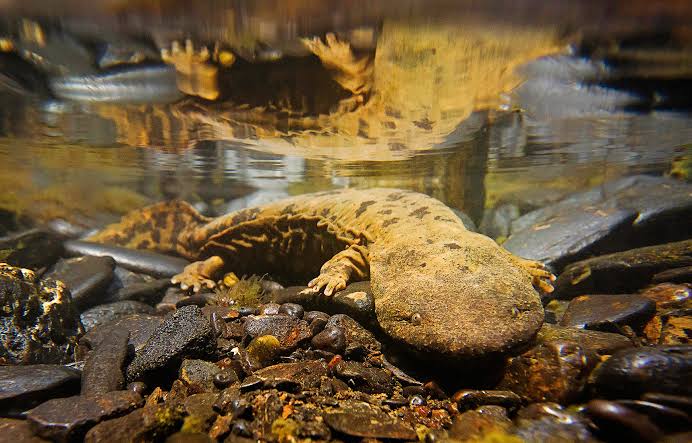The hellbender (Cryptobranchus alleganiensis), also known as the hellbender salamander, is a species of aquatic giant salamander endemic to the eastern and central United States. It is the largest salamander in North America. A member of the family Cryptobranchidae, the hellbender is the only extant member of the genus Cryptobranchus. Other closely related salamanders in the same family are in the genus Andrias, which contains the Japanese and Chinese giant salamanders. The hellbender, which is much larger than all other salamanders in its geographic range, employs an unusual means of respiration (which involves cutaneous gas exchange through capillaries found in its lateral skin folds), and fills a particular niche—both as a predator and prey—in its ecosystem, which either it or its ancestors have occupied for around 65 million years. The species is listed as Vulnerable on the IUCN Red List of Threatened Species due to the impacts of disease and widespread habitat loss and degradation throughout much of its range. With their flattened head and body, four short, stout legs, long rudder-like tail and very small beady eyes, they are well adapted to their swift, flowing stream habitats. Hellbenders retain a few juvenile traits as adults, such as an absence of eyelids and open gill slits. Hellbenders prefer swift running, well oxygenated, unpolluted streams and rivers. An important physical characteristic of these habitats is the presence of riffle areas and abundant large flat rocks, logs or boards which are used for cover and nesting sites. Its diet is mostly crayfish, supplemented by small fish, other hellbenders, tadpoles, toads and water snakes. They are "sit-and-wait" (ambush) predators and conceal themselves beneath rocks on the streambed with only their head protruding to seize crayfish and other small aquatic prey that swim by. After having covered 30-60 feet and eaten up to 4 crayfish in a night, the salamander returns to its home rock by morning. Adults are extremely territorial, usually chasing off any daytime visitors. Juvenile hellbenders have many predators, including fish, turtles, water snakes, and other hellbenders. Adults have few predators, but may be eaten by raccoons, minks, and river otters. Like all salamanders, the Eastern hellbender has a four-stage life cycle, growing from egg to larva, juvenile to adult. Hellbenders reach sexual maturity at five to six years and may live as long as 30 years.
